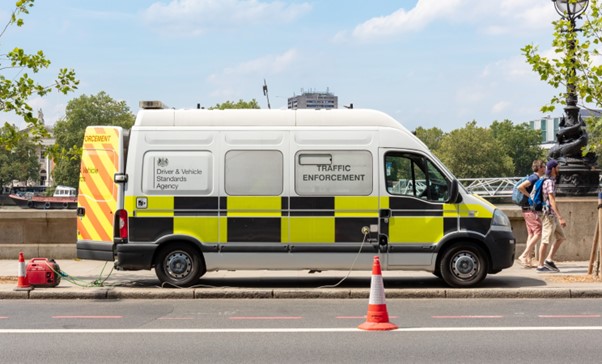
Susie Jones
Paaiškinti DVSA atliekami sunkiasvorių sunkvežimių patikrinimai
Sukurta: 08-08-2024
•
Atnaujinta: 08-08-2024
Dirbant sunkvežimio vairuotoju jus gali sustabdyti Vairuotojų ir transporto priemonių standartų agentūra (DVSA). Naujiems sunkvežimių vairuotojams tai gali būti bauginantis procesas. Tačiau, žinant esminius DVSA sunkvežimių patikrinimų aspektus, šis procesas gali kelti mažiau streso.
Kas yra DVSA?
Pasak Gov.uk, DVSA yra atsakinga už "komercinių vairuotojų ir transporto priemonių patikrinimus keliuose, kad įsitikintų, jog jie laikosi saugos taisyklių ir jų transporto priemonės yra saugios vairuoti".
DVSA gali atlikti jūsų sunkvežimio patikras vietoje ir išduoti draudimus. Draudimai neleidžia sunkvežimio vairuotojui važiuoti, kol bus išspręsta su jo transporto priemone susijusi problema.
Policija taip pat turi teisę sustabdyti sunkvežimio vairuotoją ir atlikti panašius patikrinimus.
Kaip atrodo DVSA egzaminatoriai?
Yra keletas būdų, kaip atpažinti DVSA egzaminuotoją. Jie dėvi geltonas matomumo liemenes su DVSA logotipu ir visada turi įsakymo kortelę. Jų automobiliai turi juodai geltoną raštą su DVSA logotipu ant variklio dangčio.

Kas nutiks, jei jus sustabdys?
Nesustojimas, kai DVSA tikrintojas paprašo sustoti, yra pažeidimas. Jei egzaminuotojas paprašys jūsų sustoti, jis tikrins kelyje arba specialioje testavimo vietoje. Pagrindinis šių sustabdymų tikslas - neleisti nesaugioms transporto priemonėms išvažiuoti į kelią.
Egzaminuotojas atliks šiuos privalomus patikrinimus:
Patikrina leistiną krovinio svorį ir krovinio tipą.
Mechaninių gedimų ir techninės būklės patikrinimas
Tachografo įrašų teisingumo užtikrinimas
Įsitikinkite, kad turite galiojantį vairuotojo pažymėjimą.
Kiek laiko trunka DVSA apvažiuojamasis patikrinimas?
Vidutiniškai DVSA apvažiavimas trunka 15 minučių. Tačiau tais atvejais, kai sunkvežimis neatitinka saugos reikalavimų, ji gali užtrukti ilgiau. Egzaminuotojas turi atlikti būtinus patikrinimus, neatsižvelgdamas į laiką.
Kaip įsitikinti, kad jūsų transporto priemonė yra tinkama eksploatuoti
Vairuotojas privalo užtikrinti, kad jo sunkvežimis būtų tinkamas eksploatuoti kelyje. Prieš kiekvieną kelionę rekomenduojama atlikti apvažiavimo patikrą.
Patikrinkite šiuos elementus:
Šviesos
Rodikliai
Kuras ir alyva
Padangos
Ratų tvirtinimo įtaisai
Kūno priežiūra
Priekabos sukabinimo įtaisas
Krovinys ir kita įranga
transporto priemonės patikrinimas kabinoje (pvz., saugos diržų, garso signalo, valytuvų, ploviklių, vairo mechanizmo ir aukščio indikatoriaus).
Be to, sunkvežimio vairuotojas privalo raštu pranešti savo organizacijai apie bet kokius defektus. Juose turėtų būti nurodyta:
Transporto priemonės registracijos arba identifikavimo ženklas
Patikrinimo data
Išsami informacija apie defektus
Asmens, pranešusio apie defektus, vardas ir pavardė.
Operatoriaus pareigos
Transporto priemonių valdytojai yra atsakingi už tai, kad jų transporto priemonės būtų saugios, ir privalo atlikti šiuos veiksmus:
Ūkio subjektas privalo užtikrinti, kad būtų reguliariai atliekami visų komercinių transporto priemonių saugos patikrinimai.
Jie turi užtikrinti, kad jų vairuotojai suprastų, kokius patikrinimus reikia atlikti.
Draudimai pakelėse
Jei jūsų sunkvežimis netinkamas eksploatuoti, DVSA gali jums išduoti du skirtingus draudimus - nedelsiant arba su atidėjimu.
Pranešimas apie skubų draudimą:
Jis gali įsigalioti iš karto
Daugeliu atvejų transporto priemonė bus imobilizuota.
Dėl neatidėliotinų draudimų gali būti pradėtas baudžiamasis persekiojimas.
Pavėluotas pranešimas apie draudimą:
Operatorius turi per 10 dienų išspręsti problemas.
Po dešimties dienų pareigūnai dar kartą patikrins transporto priemonę.
Prieš pradedant važiuoti sunkvežimiu, draudimai turi būti pašalinti.
Techninės apžiūros draudimai
Jei sunkvežimis turi mechaninių problemų arba jo kėbulas ir įranga yra prasto lygio, išduodamas techninės apžiūros draudimas. Už Jungtinės Karalystės ribų esančių transporto priemonių atveju vairuotojui iš karto taikomas draudimas. Jungtinės Karalystės operatoriams draudimo rūšis priklausys nuo to, kokio rimtumo yra defektas.
Nedideli defektai:
Dėl nedidelių defektų draudimas gali būti atidėtas
Operatoriui suteikiama ne daugiau kaip dešimt dienų defektams pašalinti.
Pakartotinis patikrinimas bus atliekamas po dešimties dienų.
Sunkūs defektai:
Vairuotojui už sunkų defektą skiriamas "S" ženklu pažymėtas draudimas.
"S" ženklu pažymėtas draudimas taikomas, kai kyla techninės priežiūros problema
Jei ekspertas nusprendžia, kad tiesioginės rizikos nėra, draudimus galima atidėti.
Transporto priemonė bus imobilizuota ir jums gali būti iškelta baudžiamoji byla.
"S" ženklu pažymėtas draudimas nebus taikomas toliau išvardytiems atvejams:
Jei kelionės metu iškilo problema
Problemos nepavyko aptikti (pvz., apatinės dalies defektas).

Perkrovos draudimai
Jei transporto priemonė yra perkrauta, DVSA egzaminuotojas gali ją imobilizuoti. Arba egzaminuotojas gali nukreipti sunkvežimį į netoliese esančią vietą, kur krovinys gali būti perskirstytas arba pašalintas. Transporto priemonės valdytojas gaus pranešimą.
Vairuotojo darbo valandų draudimai
Vairuotojams, nesilaikantiems tachografo ir vairuotojo darbo valandų taisyklių, bus taikomas draudimas. Už tai gali būti skirta bauda, iškelta baudžiamoji byla arba transporto priemonė gali būti imobilizuota.
Daugiau apie tachografų taisyklės ir nuostatai
Nors sunkvežimių vairuotojams DVSA egzaminai gali kelti baimę, jie neabejotinai prisideda prie kelių eismo saugumo. Užtikrinę, kad atliksite tinkamus patikrinimus ir laikysitės svarbiausių taisyklių ir nuostatų, galėsite sklandžiai išlaikyti DVSA egzaminą.
Kiek laiko turite saugoti sunkvežimių defektų lapus?
Nulinių defektų ataskaitų sistemos įdiegimas gali būti jūsų pirmoji gynybos linija įrodant, kad jūsų transporto priemonės yra tinkamos eksploatuoti kelyje. Apie defektų šalinimo darbus turėtų būti pranešama ir jie turėtų būti saugomi iki 15 mėnesių. Jei defektų nėra, įmonė turėtų saugoti įrašus, kad įsitikintų, jog vairuotojai atlieka patikrinimus.
Kaip dažnai reikia tikrintis sveikatą, kad išlaikytumėte vairuotojo pažymėjimą?
Norint gauti ir turėti sunkiasvorės krovininės transporto priemonės vairuotojo pažymėjimą, privaloma atlikti sunkiasvorės transporto priemonės vairuotojo sveikatos patikrinimą - be jo vairuotojo pažymėjimas nebus išduotas.
Jaunesniems nei 45 metų vairuotojams sveikatos draudimas galioja iki 45-ojo gimtadienio. Tačiau sulaukę šio amžiaus privalėsite kas penkerius metus iki 65 metų amžiaus atlikti sveikatos patikrinimą. 65 metų ir vyresni vairuotojai sveikatos patikrinimą privalo išlaikyti kasmet.



